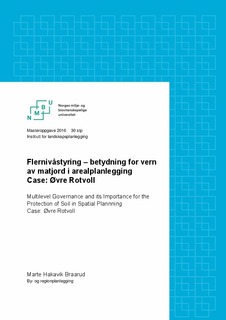| dc.contributor.advisor | Hongslo, Eirin | |
| dc.contributor.author | Braarud, Marte Hakavik | |
| dc.date.accessioned | 2016-08-25T12:57:11Z | |
| dc.date.available | 2016-08-25T12:57:11Z | |
| dc.date.issued | 2016-08-25 | |
| dc.identifier.uri | http://hdl.handle.net/11250/2401789 | |
| dc.description.abstract | Oppgaven tar for seg forholdet mellom statlig styring og kommunalt selvstyre i arealplanlegging. Dagens planpraksis består i dag av en flernivåmodell, der kommunen skal ivareta nasjonale målsetninger knyttet til jordvern. Innsigelsesinstituttet er et statlig styringsmiddel som skal sikre at den nasjonale politikken følges opp lokalt, og griper derfor inn i det lokale selvstyret. Flernivåstyring handler om maktfordeling og interessemotsetninger mellom stat og kommune, og om avveining mellom vekst og utvikling lokalt, og vern og bærekraftig utvikling.
Trondheim kommune og Øvre Rotvoll er valgt som case i denne oppgaven. Trondheim kommune står ovenfor en høy forventet befolkningsvekst. I likhet med de fleste byer og tettsteder, ligger Trondheim i tilknytning til sentrale jordbruksområder. Nasjonale retningslinjer for kompakt by- og tettstedsutvikling medfører et stort utbyggingspress på sentrumsnære jordbruksområder. Ved utarbeidelse av kommunens arealplan for 2014-2024, ble området Øvre Rotvoll, bestående av dyrka mark, vedtatt omdisponert til bolig- og næringsformål.
Oppgaven har som mål å belyse hvordan avveiningene mellom jordvern og utbygging er blitt ivaretatt i på Øvre Rotvoll. Dette skal danne grunnlaget for å svare på hovedproblemstillingen: I hvilken grad ivaretar den norske flernivåstyringen hensynet til fellesressursen som matjord er i arealplanlegging? | nb_NO |
| dc.description.abstract | The thesis deals with the relationship between state management and local self-government in land use planning. Today's plan practice consists of a multi-level model, where the municipality to safeguard national objectives relating to soil conservation. Objections is a state control that means to ensure that national policies are followed up locally and grabs therefore into the local self-government. Multilevel governance is about the separation of powers and conflicts of interest between government, and the trade-off between growth and local development, and the protection and sustainable development.
Trondheim and Øvre Rotvoll selected as a case in this task. Trondheim municipality faces a high growth in population. As with most cities and towns, located Trondheim adjacent to key agricultural areas. National guidelines for compact urban development involves a great development pressure on down town farmland. In preparing the municipality's land-use plan for 2014-2024, the area was Øvre Rotvoll, consisting of cultivated land, approved appropriations to residential and commercial purposes.
The exercise aims to show how the tradeoffs between soil conservation and development has been maintained in the Øvre Rotvoll. This will form the basis for answering the main question is: To what extent is responsible for the Norwegian multi-level governance considerations of public resource that topsoil is in spatial planning? | nb_NO |
| dc.publisher | Norwegian University of Life Sciences, Ås | |
| dc.subject | jordvern | nb_NO |
| dc.subject | Jordvern | nb_NO |
| dc.subject | Flernivåstyring | nb_NO |
| dc.subject | flernivåstyring | nb_NO |
| dc.title | Flernivåstyring – betydning for vern av matjord i arealplanlegging : case: Øvre Rotvoll | nb_NO |
| dc.title.alternative | Multilevel Governance and its Importance for the Protection of Soil in Spatial Plannning. Case: Øvre Rotvoll | nb_NO |
| dc.type | Master thesis | nb_NO |
| dc.source.pagenumber | 74 | nb_NO |
| dc.description.localcode | M-BYREG | nb_NO |
